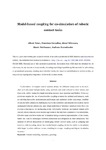Mostrar o rexistro simple do ítem
Model-based coupling for co-simulation of robotic contact tasks
| dc.contributor.author | Peiret, Albert | |
| dc.contributor.author | González Varela, Francisco Javier | |
| dc.contributor.author | Kövecses, József | |
| dc.contributor.author | Teichmann, Marek | |
| dc.contributor.author | Enzenhoefer, Andreas | |
| dc.date.accessioned | 2022-04-05T07:05:00Z | |
| dc.date.available | 2022-04-05T07:05:00Z | |
| dc.date.issued | 2020-10 | |
| dc.identifier.citation | A. Peiret, F. González, J. Kövecses, M. Teichmann and A. Enzenhoefer, "Model-Based Coupling for Co-Simulation of Robotic Contact Tasks", in IEEE Robotics and Automation Letters, vol. 5, no. 4, pp. 5756-5763, Oct. 2020, doi: 10.1109/LRA.2020.3010204. | es_ES |
| dc.identifier.issn | 2377-3766 | |
| dc.identifier.uri | http://hdl.handle.net/2183/30397 | |
| dc.description.abstract | [Abstract] Co-simulation of complex robotic systems allows the different components to be modelled and simulated independently using methods and tools tailored to their nature and time-scale, which makes the implementation process more modular and flexible. Some applications require the use of non-iterative coupling schemes for optimal performance, such as real-time interactive environments and human and hardware-in-the-loop setups. Stability of non-iterative schemes is challenging due to the restricted and delayed information that is exchanged between subsystems, and robust prediction of interface variables is key. Here, we propose a framework for exchanging model information between mechanical systems with contact, where reduced-order models approximate the interface dynamics of the subsystems. Effective mass and force terms are formulated using a reduced representation of the model, which can then be exchanged between subsystems and integrated in their simulation. The analysis of several simulations of challenging robotic contact tasks, such as grasping and insertion with jamming, shows that model-based coupling allows for stable co-simulation with larger interface stiffness values, resulting in stronger coupling and higher simulation accuracy. | es_ES |
| dc.description.sponsorship | MINECO; RYC-2016-20222 | es_ES |
| dc.language.iso | eng | es_ES |
| dc.publisher | IEEE | es_ES |
| dc.relation.uri | https://doi.org/10.1109/LRA.2020.3010204 | es_ES |
| dc.rights | ©2020 IEEE. Personal use of this material is permitted. Permission from IEEE must be obtained for all other uses, in any current or future media, including reprinting/republishing this material for advertising or promotional purposes, creating new collective works, for resale or redistribution to servers or lists, or reuse of any copyrighted component of this work in other works. | es_ES |
| dc.subject | Robotics | es_ES |
| dc.subject | Co-simulation | es_ES |
| dc.subject | Model-based coupling | es_ES |
| dc.subject | Contact | es_ES |
| dc.subject | Dynamics | es_ES |
| dc.subject | Robótica | es_ES |
| dc.subject | Co-simulación | es_ES |
| dc.subject | Acoplamiento basado en modelos | es_ES |
| dc.subject | Contacto | es_ES |
| dc.subject | Dinámica | es_ES |
| dc.title | Model-based coupling for co-simulation of robotic contact tasks | es_ES |
| dc.type | info:eu-repo/semantics/article | es_ES |
| dc.rights.access | info:eu-repo/semantics/openAccess | es_ES |
| UDC.journalTitle | IEEE Robotics and Automation Letters | es_ES |
| UDC.volume | 5 | es_ES |
| UDC.issue | 4 | es_ES |
| UDC.startPage | 5756 | es_ES |
| UDC.endPage | 5763 | es_ES |
| dc.identifier.doi | https://doi.org/10.1109/LRA.2020.3010204 |
Ficheiros no ítem
Este ítem aparece na(s) seguinte(s) colección(s)
-
LIM - Artigos [43]






